The Huaorani of Ecuador lived as hunters and gatherers in the Amazonian rainforest for hundred of years, largely undisturbed by western civilization. Since their first encounter with North American missionaries in 1956, they have held a special place in journalistic and popular imagination as "Ecuador's last savages." Trekking Through History is the first description of Huaorani society and culture according to modern standards of ethnographic writing. Through her comprehensive study of their extraordinary tradition of trekking, Laura Rival shows that the Huaorani cannot be seen merely as anachronistic survivors of the Spanish Conquest. Her critical reappraisal of the notions of agricultural regression and cultural devolution challenges the universal application of the thesis that marginal tribes of the Amazon Basin represent devolved populations who have lost their knowledge of agriculture. Far from being an evolutionary event, trekking expresses cultural creativity and political agency. Through her detailed comparative discussion of native Amazonian representations of history and the environment, Rival illustrates the unique way the Huaorani have socialized nature by choosing to depend on resources created in the past—highlighting the unique contribution anthropology makes to the study of environmental history.
- THE HISTORICAL ECOLOGY SERIES
- [ Contents ]
- Illustrations and Tables
- Preface
- Acknowledgments
- Note on Orthography
- Trekking Through History
- CHAPTER ONE: Trekking in Amazonia
- Cross-Cultural Generalizations About Amazonian Societies
- Amazon Trekkers
- CHAPTER TWO: The Upper Amazon from Omagua Expansion to Zaparo Collapse
- Historiography and Isolationist People
- The Presence of Tupian People in the Upper Amazon
- The Napo-Curaray Geopolitical Landscape at the Time of Correrías
- The Fate of Zaparoan Peoples During the Rubber Era
- Recorded Huaorani History
- Historical Isolation, Adaptation, and Continuity
- CHAPTER THREE: The Time and Space of Huaorani Nomadic Isolationism
- Knowing, Remembering, and Representing the Past
- Primeval Predation and Survival
- Anger and Homicide
- Warfare, History, and Kinship
- From the Victim’s Point of View
- CHAPTER FOUR: Harvesting the Forest’s Natural Abundance
- An Economy of Procurement
- Chonta Palm Groves, Fructification, and Forest Bounty
- The Giving Environment
- CHAPTER FIVE: Coming Back to the Longhouse
- The Longhouse: To Belong and to Reside
- The Sharing Economy
- Affinal Pairing and Maternal Multiplicity
- The Dialectics of Incorporation and Separation
- A Gap in the Canopy
- CHAPTER SIX: Eëmë Festivals: Ceremonial Increase and Marriage Alliance
- Ahuene: The Tree Couple
- The Human Birds
- Birds and Wild Boars
- Tying the Knot
- Ceremonial Drinking, “Wild” Marriages, and Social Distance
- The Asymmetry Between Hosts and Guests
- Alliance and Residence: A Comparative Perspective
- Photos
- CHAPTER SEVEN: Schools in the Rain Forest
- Schooling, Identity, and Cultural Politics
- Legacy of the Summer Institute of Linguistics
- We Want Schools to Become Civilized
- Civilized Bodies in the Making
- Schools as Public Centers of Wealth
- Trekking Away from School Villages
- The Naturalization of Impersonal Donors
- CHAPTER EIGHT: Prey at the Center
- Notes
- References
- Index

